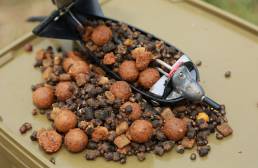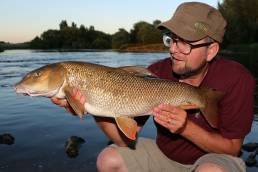
BAIT LIKE BOWLER - A GUIDE TO BAITING RIVERS
26th August 2020
Sticky is synonymous with catching carp from pits, lakes and ponds up and down the country so it should come as no surprise that the range is also deadly on rivers.
Don’t believe that you’ll only be using Sticky to catch carp in this scenario because if you fish for chub, barbel or roach there’s something in the range for you too. Flowing water comes with a huge advantage for a highly attractive bait, the movement will carry any scent trail so much further than it would on a still water in turn alerting the fish far quicker. Unfortunately this advantage can also hinder us while fishing because accurate baiting becomes an issue. In all but the slowest moving sections of river, throwing in loose feed is problematic and in some cases the offerings won’t reach the bottom until a long way downstream. So let’s take a look at a few of the ways I angle, ensuring I get the presentation and bait placement I want.
A traditional way to achieve accuracy is via a baitdropper which is generally a round metal container with a door on the front that opens on impact with the bottom. When utilising this method I use a separate rod of around 2½lb test curve teamed with a minimum of 15lb line. Anything from Krill boilies to Bloodworm pellets can be loaded into it and accuracy is guaranteed. Due to it being able to deliver baits of different sizes it’s perfect for introducing the mixed banquet that I favour in summer. Bloodworm, Ellipse and trout pellets are combined with whole and crushed Krill boilies along with a little hemp. Ideally the night before I’ll also add lots of Hemp Oil and a good dose of Krill glug. Once this has marinated, it offers potent attraction with lots of flavours leaching off downstream.

A traditional way to achieve accuracy is via a baitdropper which is generally a round metal container with a door on the front that opens on impact with the bottom. When utilising this method I use a separate rod of around 2½lb test curve teamed with a minimum of 15lb line.
Anything from Krill boilies to Bloodworm pellets can be loaded into a baitdropper and accuracy is guaranteed. Due to it being able to deliver baits of different sizes it’s perfect for introducing the mixed banquet that I favour in summer. Bloodworm, Ellipse and trout pellets are combined with whole and crushed Krill boilies along with a little hemp. Ideally the night before I’ll also add lots of Hemp Oil and a good dose of Krill glug. Once this has marinated, it offers potent attraction with lots of flavours leaching off downstream.
A great hookbait to use over the mix is half a boilie fished on a tight hair.

The reason for this tactic is that you can actually use the flow to your advantage and make the boilie fall over and hide your hook as it acts like a cup due to the flat bottom on one side and the push of water. Trust me barbel see the metal work and this also applies to carp in both rivers and stillwaters!
However great the baitdropper is, it does have a limitation and that is the door struggles to open when cast any further than an underarm lob and it certainly is not any good for an overhead cast. On very slow moving rivers a spomb could be used but accuracy is questionable especially when using the type of mixture I’ve described.
There is however a hybrid between a spomb and a baitdropper called a Spopper that is a godsend. Not available in the mainstream market it’s a case of searching eBay for these conversions but if you’re fishing big rivers like the Thames or Trent it’s worth the effort to find them. With the casting benefits of a spomb and the pin opening the door only on impact with the bottom it’s the best of both worlds. They are expensive so I team mine with 50lb braid and a spomb rod but now you’ll be able to deliver all of the Sticky range at any distance highly accurately in flowing water albeit with a bit of commotion.

There is a hybrid between a spomb and a baitdropper called a Spopper - it really is a godsend!
Groundbait is another traditional way of delivering bait like the bait dropper and although there is an element of guesswork this can be minimal if the mix you use is heavy. Krill Active mix is perfect and generally I use it on a 50:50 basis with halibut or trout pellet powder. It will bind the mix, add weight and also increase the attraction level ten-fold. I also like to include a liquid food source and the Liquid Liver takes some beating. This really is a brilliant addition and while it stinks it’s never far away from any scenario when it comes to my carp and barbel fishing. When including any liquids to groundbait it’s vitally important that you put it into the water you’re going to use rather than the dry mix itself to achieve even distribution, then add the water very slowly to the groundbait and keep moving it vigorously. Once you can ‘ball’ it up, leave it for at least 15 minutes and give it another good mix with damp hands and this will probably be enough to replace the lost moisture that is soaked up during this time span. Only when you’re sure it’s perfect add broken boilies and pellets but not too many as you need plenty of groundbait to keep it from breaking up during catapulting. You know you’ve got the mix correct when it lands on the surface with a noise similar to a stone. It will sink fast and only deviate a little due to the flow helping you achieve that all-important accuracy. Giving exact instructions is difficult in angling because there are so many variables, but 6-8 tangerine size balls is a good starting point which can be added to if you start to catch.
The mix I’ve described also makes an incredible combination with a method feeder for barbel. Although not a tactic normally associated with rivers if you find a shoal of barbel then it can be unbeatable It’s my first choice on the Wye because there are lots of hungry fish present who can never resist a free meal. A match angler on a still water wants his mix to explode quickly but that’s exactly what you want to avoid or else the flow will leave you with just an empty frame very quickly. By making it tacky it forces the barbel to knock it to dislodge the pellets you’ve added, which in turn causes competition in the shoal as the frenzy builds to be the first to get the food. Team it up with a short hooklength and plenty of pellets; they’ll be crawling up the rod I promise. If you haven’t had a bite in 15 minutes keep recasting on this timescale until you do because the key is to keep feeding the swim. I get lots of questions on how to fish the Wye and my answer is always the same – ‘don’t forget to take the method’.
There are of course other types of feeders and if you choose to fish a long hooklength, which is popular on the Trent, then I’d use the Krill Active mix/trout pellet groundbait combo to plug an open end feeder and fill the centre of the vessel with a mixture of Ellipse/Krill/Bloodworm pellets, soaked in Pure Salmon Oil to pimp the attraction up still further. This allows me to get a good bed of bait down quickly and accurately with the key again regular recasting especially to begin with. A tip when fishing very long hooklengths is to actually stick the hook bait into the bottom of the feeder thus eliminating tangles completely. If it’s done gently it will dislodge either as the feeder falls through the water column or the moment of touchdown before the flow takes control unfolding the hooklength into position. Don’t ignore the block end feeder either, which is suitable for the smaller 2 and 4mm pellets in the range. They can be delivered neat and the river will push them through the holes but if you have any issues with this insert a pair of scissors into each hole and twist making them a bit bigger. Whatever feeder you select accuracy is the key so ensure you keep putting it in the same spot each and every cast.
PVA mesh bags also play a role in my river fishing especially when using boilies and larger pellets. I have to admit for all species I’m a Krill addict and this coming winter I can’t wait to try out the new Active boilies because they appear perfect for river fishing with their outer coating slowly breaking down and the river creating a huge scent trail. The Ellipse pellets are also brilliant and work extremely well in PVA mesh bags. I don’t think I need to explain to anyone how to tie a bag up but do consider where you attach them to your terminal tackle prior to casting out. In slower flows the standard still water tactic of nicking the hook under the knot works fine but this should be avoided in faster flows because the bag melts and the free offerings will be pulled well away from the hookbait. Instead try tying or attaching the bag to the lead via a knot or a snap link then when it dissolves the freebie will tumble down over your hooklength with your hookbait first inline as the fish move upstream just waiting to be eaten.
So in conclusion, the flow can be your friend and foe. You can utilise it to create a scent trail far better than is possible on a still water but your baiting strategy needs more consideration because the flow and its strength will dictate that using a catapult with loose bait is normally too haphazard. What I can assure you though is get it correct and you can fish with confidence on a river using the whole of the Sticky range, carp adore it but so do chub and barbel making it the perfect choice for your flowing water campaign.














